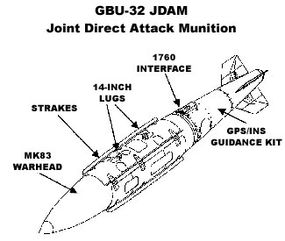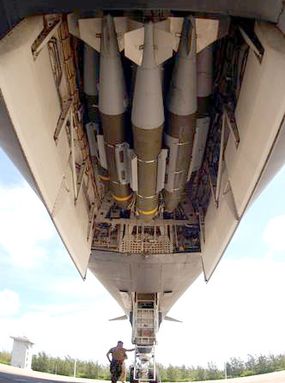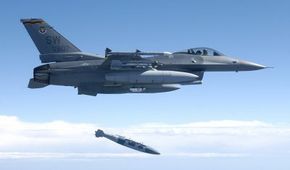The JDAM
The preeminent smart-bomb technology of the day is Boeing's JDAM, which stands for Joint Direct Attack Munition. The basic idea behind the JDAM program is to outfit existing "dumb" bombs with sophisticated rear guidance sections. The U.S. Air Force is currently using JDAM with the 2,000-pound (907-kg) BLU-109 or MK-84 warhead or the 1,000-pound (454-kg) BLU-110 or MK-83 warhead.
The JDAM "tail kit" includes adjustable tail fins, a control computer, an inertial guidance system and a GPS receiver. Both the GPS receiver and the inertial guidance system allow the bomb to locate itself in space. The GPS receiver figures out its position by interpreting GPS satellite signals (see How GPS Receivers Work), while the inertial guidance system monitors the bomb's movements, tracking its path from its launch position.
Advertisement
Before dropping the bomb, the aircraft uses its own GPS receiver to pinpoint particular targets on the ground. Just before releasing the bomb, the aircraft's computer feeds the bomb's computer its current position and the GPS coordinates of the target.

In the air, the JDAM's GPS receiver processes signals from GPS satellites to keep track of its own position. As with other smart bombs, the control system adjusts the flight fins to "steer" the bomb in the right direction. According to the U.S. Air Force, the system is accurate to within 40 feet (13 meters). When everything goes exactly right, the bombs generally hit within a few feet of their targets.
This system works fine even in bad weather, because the JDAM gets all its information from satellite signals, which aren't blocked by cloud cover or obstacles. The bomb doesn't have to see anything at all to find its way to the target. And at around $20,000 per tail kit (which can be added to an existing warhead), it's much more economical than $120,000+ laser-guided bombs.

The JDAM played a major role in the U.S. invasion of Afghanistan in 2001, and it will certainly play a significant role in any U.S. bombing campaigns in the near future. While the newest smart bombs aren't 100 percent accurate, they are such an improvement over their predecessors that they're quickly taking over the U.S. arsenal.
For more information about smart bombs and other types of ordnance, check out the links in the next section.
